Description: War Thunder is a next generation military MMO game dedicated to...

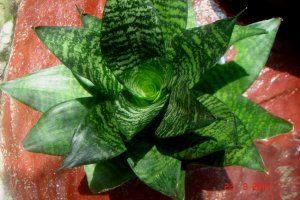
natural environment habitats of most indoor plants are regions with a tropical and subtropical climate. Therefore, for normal development, they need intensive lighting. In addition, there are indoor plants that do not require light. We propose to talk about them.
Ferns are very popular among Russians. AT natural conditions These plants grow in the shade of trees. Therefore, they do not need bright sunlight at all. The most popular among flower growers are such representatives of the fern family as Polypodium, Adiantum venus hair and Nephrolepis.
The most unpretentious in indoor cultivation is Nephrolepis. It develops normally even in unheated rooms. By and large, all ferns are unpretentious and grow well in partial shade and cool air. Plant them in light fertile soil from a mixture of leafy soil, humus and sand. Water and mist the leaves regularly during hot weather. 
The Sansevieria plant, also known as the Indian Sword and Pike Tail, also tolerates partial shade conditions. This is a completely unpretentious plant that develops equally well in cool and hot conditions, in dry and humid air. It will not disappear, even if the earth in the pot dries out regularly. This plant is distinguished by thick fleshy leaves and a weak root system. The only thing it cannot bear is excess watering and stagnant moisture. For planting, it is necessary to use loose soil, consisting of humus, leafy soil and sand.
I must say that most indoor plants that do not require light do not need special care. In this regard, Cyrtomium sickle, perhaps, broke all records. This plant calmly tolerates cold and can withstand wintering on the balcony at temperatures up to 0 ° C.
This plant needs moderate watering. Periodic drying of the soil will only benefit him. However, in spring and summer, once a month, this flower requires rain watering. To do this, take the plant pot to the bathroom, and feel free to water it under the shower. 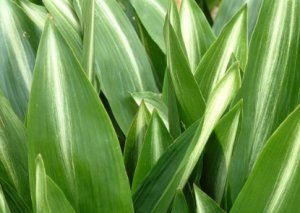
Another interesting shade-tolerant plant is Aspidistra, also known as the Friendly Family. This beautiful flower got into our apartments from the forests of East Asia. There it grows in heavily shaded areas. Therefore, the darkest nooks and crannies of the room are suitable for him. This plant is not demanding either on the composition of the soil or on watering. Does not need special care.
The dark green leaves of Aspidistra tolerate the content in dry, dusty conditions. dark brown flowers Aspidistra look like fish scales. They appear near the ground and are almost invisible. The luxurious leaves of this plant are of decorative value.
Some indoor plants that do not require light can effectively decorate walls. These include common ivy. It is worth noting that varieties with variegated leaves still require more intense lighting. But with its shortage, the plant will not disappear, just its leaves will turn dark green. Ivy should be planted in fertile soil and watered abundantly. In addition, in the summer and during the heating season, it is necessary to regularly spray its leaves.
Another shade-tolerant Spartan is Chlorophytum. He puts up not only with low lighting, but also with irregular watering. It should be planted in loose and fertile soil. Watering can be irregular, but plentiful. And during the heating season, the plant must be periodically sprayed. 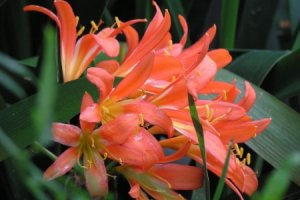
For lovers of flowering indoor plants that do not require bright light, Clivia is suitable. It pleases the eye not only with exceptionally beautiful dark green leaves, but also with bright flowers. They are collected in umbellate inflorescences, the number of which can reach 20 pieces. Clivia requires fertile soil and abundant watering in summer.
Almost all representatives of the Aroid family also normally tolerate content in low light conditions. In summer they are kept under diffused lighting, and in winter you can even remove the flower to the far corner of the room in the shade. Some types of Aroids bloom indoors. But the shape of the flowers is very specific and looks more like a variegated leaf, usually scarlet.
In addition to the listed plants, Bromeliads, Ficuses, many palm trees, Cyperus, Dracaena, Monstera, Syngonium, Cissus do not need bright light.
Why do people grow indoor flowers? After all, flowers must be constantly looked after, replanted, and selected for them a place and water. Probably because people want to be closer to nature, they are waiting for harmony and a miracle. It's so beautiful when the real thing grows and blooms in the apartment. living plant! Therefore, residents of the tropics, deserts, forests and meadows grow in apartments. But people do not always know how to choose the right indoor plants and create conditions for their life: some need a lot of sun, some shade, other plants love humid climate and some don't need to be rehydrated. First you need to figure out how to choose the right indoor plants for your own home, given the conditions of detention. If there is little sun in the apartment, then shade-loving indoor flowers will ideally take root in such conditions.
65 523159
Photo gallery: Indoor flowers that do not like light
Shade-loving flowers: botanical features
First you need to determine what shade-loving plants are and what shade-tolerant ones are. There is a big difference between them. Shade-loving plants in nature grow only in the shade. Direct sunlight is harmful to them, it can lead to leaf burn. For example, shade-loving indoor plant- fern.
shade tolerant plants- others, they are comfortable in bright light, but calmly tolerate shade. These plants have external differences from the light-loving. Their leaves are wide, thin, soft, smooth to the touch and flat. This is due to the fact that such leaves need to capture as much light as possible, which is scattered in the shade.
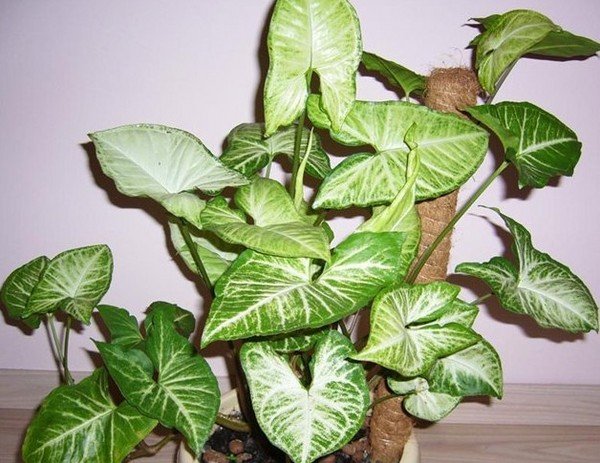
Dark-loving indoor flowers
In floriculture, there is not much difference between shade-loving and shade-tolerant plants. Both can equally be grown in shady rooms, on windows facing north and west. For successful growth, they need fertile soil, it is the main condition. This is due to the fact that under natural conditions shade-loving plants exist under the shade of trees, a small amount of light is compensated by substances from the soil. Therefore, such plants are well absorbed nutrients soil.
Shade-loving plants are distinguished by beautiful decorative leaves, for which they are valued. But such plants bloom in poor light is not very good. Of all the plants, you can choose a few that do not require special care, and are decorative at the same time.
Deciduous indoor shade plants
Calathea
This plant is shade-tolerant, loves moisture, but does not tolerate temperature changes.
Aglaonema
Very similar to dieffenbachia, but smaller. AT winter time additional lighting is needed.
Fittonia
This houseplant loves partial shade, but does not tolerate direct sunlight. In winter, additional lighting is also needed.
Tree shade plants
ficuses
These plants grow quickly and have no special light requirements. They are suitable for residential and service premises, for winter gardens.
Aucuba
Under natural conditions, it lives in subtropical forests, has a strong shade tolerance.
Cordilina
This indoor plant does not tolerate direct sunlight, it needs diffused light for growth, and additional lighting in winter.
Yew capitate Fortuna
It is an upright evergreen columnar shrub that grows slowly and does not require light.
Shade-loving creepers
philodendrons
These are creepers that have woody branches and long aerial roots.
Ivy
This plant does not like direct sunlight, but at the same time grows quite well in lighted places. He does not like changing the position of the light source and in winter additional lighting is needed.
Scindapsus
This vine has aerial roots, leaves with white and yellow streaks. This plant grows quickly. In order for the plant to branch, it is necessary to pinch the leaves.
Cissus arctic (birch)
This plant does not tolerate direct sunlight and therefore grows well in blackout, on windows facing east and west.
Flowering shade-loving houseplants
violets
These plants bloom for a long time. They do not like direct sunlight, and in winter they need additional light.
Clivia
This beautiful plant blooms with umbellate inflorescences on tall peduncles. It needs fertile soil and good watering.
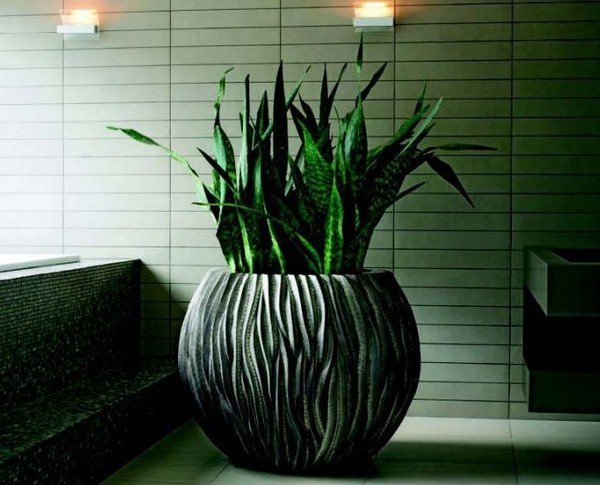
Indoor flowers that love shade
begonias
This plant loves partial shade, does not require special care.
Ferns and palms
Nephrolepis
For this plant, partial shade is good, does not like direct sunlight.
Maidenhair
This plant needs some shade and sun protection.
Pteris cretan
Needs protection from direct sunlight.
rapis
It's a slow growing palm good growth Provides bright but diffused light. Tolerates both sun and shade.
Hamedorea
It is a palm plant and needs sun protection.
This is a small list of indoor flowers that can grow in the shade. In fact, there are many more such plants for which shade is both familiar and desirable. In room conditions, you can grow some plants for the garden. A dark room can be perfectly refreshed by shade-loving plants. It is only necessary to choose suitable flowers that do not need a lot of sun.
At present, the supplementary illumination of plants with the help of artificial light is becoming more and more popular. This method of growing plants has received particular distribution abroad, but in our country it is also being used more and more.
In general, even any small lamp illuminating the plant 2 hours a day improves its conditions. However, in order to most fully meet the needs of the plant, it is better to organize a well-thought-out system of additional lighting.
Artificial supplementary lighting of plants is required in the following cases:
In winter, the apartment is very hot, and the plants do not go into a dormant state. Many species can continue to grow and bloom when artificial light is used;
There is absolutely not enough space in the apartment to accommodate all the plants. Or you want to use plants in interior design and make beautiful compositions from them in the back of the room, where there is extremely little light;
In the apartment, in principle, there is not enough light. Trees grow in front of the windows, or neighboring buildings block the sunlight.
It should immediately be determined whether we want to illuminate the plants or completely switch to artificial lighting. The fact is that not a single plant will refuse additional lighting, while only sufficiently shade-tolerant species are able to grow completely without sunlight.
An indicative list of plants that can be grown under artificial light is given below.
Saintpaulia. This is one of the most famous plants for growing under artificial lighting conditions. The duration of illumination should vary from 12 to 16 hours.
Pilea- Pilea cadierei. This small plant with colored leaves is tolerant of low light but needs high humidity.
Syngonium- Syngonium podophyllum. These plants also tolerate low light levels.
Asparagus- Asparagus densiflorus ‘Sprengeri’ and Asparagus setaceus. These plants tolerate low light levels, but grow better in medium light levels.
Croton- Codiaeum ‘Golg king.’ Plants with yellow spots require less light than other types of Croton.
begonias- Begonia: B. coccinea; B.xerythrophylla; B. masoniana; Flowering, B. semperflorens; B. rex varieties. Most begonias prefer medium light conditions. With artificial lighting, the duration of the dosvteka is 14-16 hours.
Cacti and succulents. The vast majority of plants in this group prefer very bright light and cannot be grown under artificial light. However, artificial lighting can be used if natural light is not enough for plants. High light intensity should be used and plants should be kept close to the source.
Aspidistra- Aspidistra elatior. One of the most shade tolerant plants, it can be grown successfully under artificial light.
Aglaonema- Aglaonema modestum. According to some reports, this type of aglaonema can withstand even lighting of 100 lux. Species with variegated leaves require better lighting, but can also be grown successfully under artificial light.
cissus- Cissus rhombifolia, Cissus antarctica. Cissus prefers medium light, but can be grown under artificial light.
dieffenbachia spotted- Dieffenbachia maculata. So that the plant is not very elongated and does not lose its lower leaves, it is better to provide it with average level illumination. But for some time the plant can grow under artificial lighting.
Dracaena- Dracaena fragrans massangeana; Dracaena marginata; Dracaena deremensis ‘Janet Craig’; Cordyline terminalis ‘Ti.’ Most species of dracaena are perfectly adapted to room conditions and tolerate low light levels, although they prefer medium light intensity. Cordylines are less suitable for artificial lighting, because. The brightest leaves they form in bright light.
Ferns: Asplenium- Asplenium nidus; Nephrolepis- Nephrolepis exalta bostoniensis; Cyrtomium- Cyrtomium falcatum; Maidenhair- Adiantum. They prefer medium, but easily tolerate low levels of illumination. The main secret of success is high humidity.
Episcia copper-red- Episcia cupreata varieties. Growing needs are similar to Saintpaulia.
Gloxinia- Gloxinia, Sinningia speciosa. Prefers medium light for normal flowering and compact shoots.
Hoya- Hoya carnosa ‘Hummels compacta,’ Hoya carnosa. Needs medium light for growth and high enough for flowering. Plants must not move
ivy- Hedera helix. Grow in medium to bright light.
Silver fat woman- Crassula argentea. This succulent plant is well adapted to indoor conditions. Most Crassula prefer full sun, however this species can grow in 250 lux but will produce thinner and smaller leaves.
Scheffler- Schefflera arboricola. Prefers bright light, but can grow in medium.
Araucaria- Araucaria heterophylla. This hardy plant prefers medium light but is tolerant of lower levels. With poor care and insufficient lighting, it can lose symmetry.
Calamondin - Citrus mitis. Can grow in medium to bright light levels.
Some types of orchids can be grown in medium light levels.
Palms: Areca- Crysalidocarpus lutenscens; Date fruit-Phoenix roebelenii Hamedorea- Chamaedorea elegans ‘bella’; Chamaedorea erumpens; Hovea- Howeia forsteriana. Hamedorea and howea are the most tolerant palms to light conditions. Other palm trees require at least medium light levels. Many types of palm trees can only grow in bright light.
Peperomia- Peperomia obtusifolia; Peperomia caperata. Most species of peperomia prefer medium light levels, however, they can grow in low light conditions for some time.
philodendrons- Philodendron oxycardium; Philodendron pertusum. Philodendrons with heart-shaped leaves are generally tolerant of low light conditions. Most other types of philodendron require medium light levels.
Epiprenum aureus. Good for low to medium light conditions.
sansevier- Sanseveria trifasciata. A very hardy plant, tolerates low light levels well, but grows best in medium to high light levels.
Spathiphyllum- Spathiphyllum sp., ‘Supreme’ or ‘Sensation.’ These plants are adaptable to low light conditions but require medium levels to flower.
Chlorophytum- Chlorophytum comosum ‘Vittatum.’ The plant is tolerant of low light conditions but prefers medium light.
Plectranthus- Plectranthus australis. Tolerant to low light, but more active growth and branching are observed in medium light conditions.